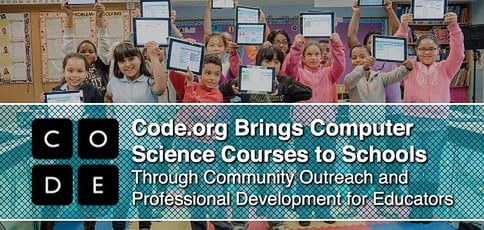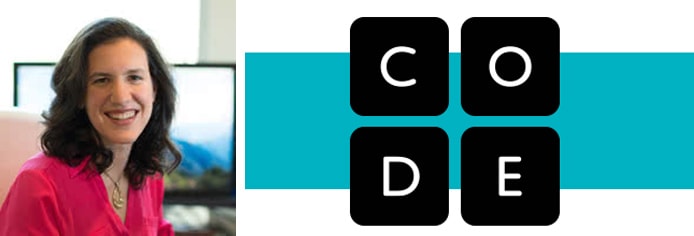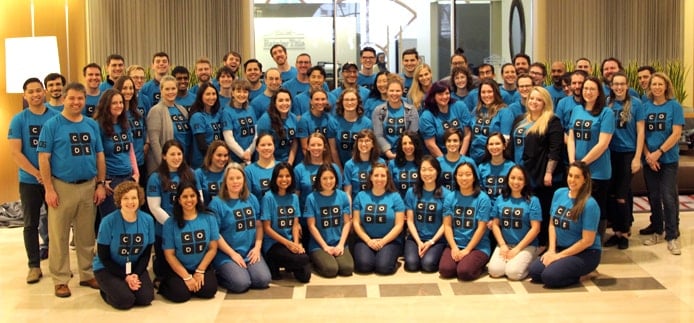
TL; DR: Even with the rise in popularity of careers in computers, many K-12 schools still don’t offer computer science classes. Code.org is trying to change that by giving educators training programs, free curricula, and other resources that empower teachers to bring computer science to their schools. We spoke with Code.org President Alice Steinglass about how the movement toward coding classes is largely teacher-led, along with how the computer science education landscape changes with community outreach efforts.
Alice Steinglass was well-versed in the challenges of finding and hiring diverse talent in the tech industry. In her efforts to create an inclusive work environment, she was amazed at how rarely she encountered women and minority applicants.
When Alice learned that most schools still don’t teach computer science, something clicked: One of the keys to a more representative workforce was to fix the problem where it starts — K-12 classrooms.
“The problem was more holistic and there was more we needed to do,” said Alice, now the President of Code.org. “If you don’t have an opportunity to take computer science in K-12, it is so hard to enter computer science in college.”
Code.org was founded on the theory that if more K-12 schools offered computer science, more students — especially those from underrepresented groups — would pursue tech fields as a career. The nonprofit offers curricula, training, and resources for teachers to inspire and empower students to code.
When girls are exposed to computer science classes in school, they’re 10 times more likely to pursue the subject in college; minority students are roughly eight times more likely to major in computer science. As such, the Code.org mantra is that anyone can learn computer science — and the best time to start the journey is now.
“If we start earlier, they have the opportunity to start to level the playing field,” Alice said. “Giving all our students that confidence is critical.”
A Teacher-Led Movement to Create Coding Programs
Getting schools on board with bringing in a computer science curriculum can be challenging, Alice said, but teachers are usually the biggest cheerleaders.
“Teachers get into teaching because they want to do what’s right for their students,” she said. “They care about their students and their futures. They’re wanting students to be empowered not just to use technology, but to help create it.”
Many teachers who use Code.org’s programs and resources have no prior experience in coding. Last year, 24,000 teachers graduated from college to teach math or science, and only 75 said they were prepared to teach computer science.
Many schools think they have to hire new teachers to offer computer science classes. This is a myth, Alice said: All that’s needed is to empower existing teachers with the skills and tools to teach the subject.
“Schools don’t have the budget to hire new teachers, but they don’t need to,” she said. “Our professional development and curriculum are all designed for teachers with no background in computer science.”
Kids Show Interest in Coding When Given Opportunity
Teachers using Code.org curricula often find that students take quickly to coding, Alice said. Computer science classes capitalize on young learners’ desire to experiment and imagine new things.
“Kids love being creators,” Alice said. “They love building, and this is an opportunity to construct games, apps, websites, and things they care about.”
Kids see coding as a creative pursuit, and it comes easier to them than learning it as an adult. Computer science is the third most popular subject for school-age children behind art and the performing arts, Alice said.

Before becoming the President of Code.org, Alice Steinglass led various teams at Microsoft.
“We’re not as cool as dance, but that’s OK,” she said with a laugh. “I think it says a lot that kids love to build and love to create.”
Alice said the K-12 students are inspiring in that they can fully embrace the subject without any preconceived notions about it.
“We start in elementary school, and one of the reasons we’re starting in elementary school is when you start that young, students don’t know what they should or shouldn’t like at that point,” Alice said. “The stereotypes of society aren’t embedded. They’re curious, they’re creative, they want to learn about the world. They want to learn about everything.”
Reaching Underrepresented Students as a Measure of Success
Code.org aims to reach students who wouldn’t otherwise have the opportunity to learn about computer science. Nearly half of the students participating in Code.org programs are girls, and nearly half are minorities.
“We really focus on reaching girls and underrepresented minorities, inspiring them, and helping them see that computer science is something they can do,” Alice said, “These groups haven’t traditionally been part of the tech field.”
Code.org curricula are designed to build equity among students who come from different backgrounds and may not have the same level of knowledge as their peers. Most courses start with foundational topics before jumping into coding.

More than 60 employees — and countless volunteers and learning partners — work on Code.org programs.
“That allows students who maybe don’t have any background in computer science to be on a level playing field and feel like they belong there,” Alice said. “By offering these classes in places that have not traditionally offered computer science classes, there’s a real opportunity to change the face of computer science and of the tech industry. There’s a lot of hope in the next generation of students.”
Mobilizing Support for Computer Science in Schools
With about 700,000 teachers using Code.org around the world, the organization continues to draw interest from new students and school systems.
“It’s amazing the impact and the scale of the audience we’re able to reach,” Alice said. “It’s really exciting for us to see the growth and be able to partner locally with organizations across the country.”
Code.org maintains a data-driven map that shows the schools in the continental US that teach computer science, and provides resources to help administrators, teachers, parents, and students get involved in coding education.
As the organization launches the Computer Sciences Discoveries course for middle school students, Code.org is also hosting a hands-on, week-long summer workshop that develops teaching skills on the subject.
Code.org works with 57 regional partners that run various workshops in their respective areas so teachers don’t have to travel far to participate.
“We’ve been expanding dramatically, so this summer we’re going to be in 43 states across the country,” Alice said. “We’re going to have over 1,000 teachers going to these workshops, and more than half the teachers say it’s the best professional development they’ve ever attended.”
HostingAdvice.com is a free online resource that offers valuable content and comparison services to users. To keep this resource 100% free, we receive compensation from many of the offers listed on the site. Along with key review factors, this compensation may impact how and where products appear across the site (including, for example, the order in which they appear). HostingAdvice.com does not include the entire universe of available offers. Editorial opinions expressed on the site are strictly our own and are not provided, endorsed, or approved by advertisers.
Our site is committed to publishing independent, accurate content guided by strict editorial guidelines. Before articles and reviews are published on our site, they undergo a thorough review process performed by a team of independent editors and subject-matter experts to ensure the content’s accuracy, timeliness, and impartiality. Our editorial team is separate and independent of our site’s advertisers, and the opinions they express on our site are their own. To read more about our team members and their editorial backgrounds, please visit our site’s About page.

